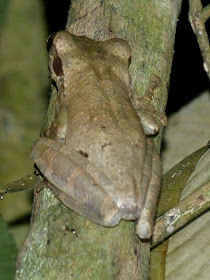There are several families of frogs throughout the world known as 'tree frogs', which have quite independently evolved to very similar forms to enable a largely arboreal lifestyle. Most conspicuous among these adaptations are large toe pads, often with a sticky mucus which allows gripping onto smooth surfaces; long limbs and toes are sometimes also evident.
 |
| Green Tree Frog Litoria caerulea, tastefully posing on a yellow brick wall (not road) in Karumba, tropical Queensland. |
The family Rhacophoridae occurs in Africa and south to south-east Asia.
 |
| Cinnamon Frog Nyctixalus pictus, family Rhacophoridae, Batang Ai NP, Sarawak. This one breeds in pools in tree hollows. |
Along with this family, the big family Hyperoliidae is widespread in Africa. I can't tell to which family the next two pictures belong (field guides in these areas are sparse, and most of the defining characters even at a family level are internal), though I suspect Rhacophoridae for both. Needless to say, I'll be happy to receive and acknowledge any suggestions!
 |
| Bwindi Impenetrable National Park, south-western Uganda |
 |
| Korup National Park, western Cameroon. |
However the 'true' tree frogs (not my term and I really have no idea what it means!) belong to the very large and widespread family Hylidae, found right across mid-latitude Eurasia, North and South America and Australia, though a Gondwanan origin has been suggested.
It is the largest frog family in Australia (since the big family of ground frogs, Myobatrachidae, was split into two - now comprising that one plus Limnodynastidae). Most species (some 70) belong to the genus Litoria; curiously the burrowing frog genus Cyclorana (about a dozen species) is in the same family.
Let's just enjoy some of these lovely Australian Litoria tree frogs.
 |
| Dahl's Aquatic Frog L. dahlii, Fogg Dam near Darwin. As the name suggests this 'tree frog' mostly lives in or near water; its toes (not visible here) have no climbing pads. |
 |
| Eastern Dwarf Tree Frog L. fallax; a small tree frog (no more than 30mm long) found along much of the east coast. It too can turn up in fruit shops far from its home, having hitched a ride. |
 |
| Javelin Frog L. microbelos, south of Darwin; the common name is apparently a reference to its pointy snout. I rescued this one from attack by Green Tree Ants in a bird hide. |
 |
| Motorbike Frog L. moorei Margaret River, Western Australia; named not from any strange habits, but its remarkable call, just like a motorbike revving up through the gears. |
 |
| Verreaux's Tree Frog L. verreauxii, subalpine Kosciuszko National Park. |
 |
| Dendropsophus leali, Rio Alto Madre de Dios, southern Peru. |
 |
| From Sacha Lodge, Yasuní National Park, Ecuador, above and below. |
 |
| Machiguenga Lodge, Manu Reserved Zone, southern Peru. |
So, tree frogs; how could you not love them?! You've probably not learnt a lot from this posting, but I hope you've enjoyed it and them! I'm sure I'll be supplementing this post with new photos from time to time.
BACK ON THURSDAY
(And remember that you can get a reminder when the next post appears by putting your email address in the Follow by Email box in the top right of this screen.)
(And remember that you can get a reminder when the next post appears by putting your email address in the Follow by Email box in the top right of this screen.)







No comments:
Post a Comment